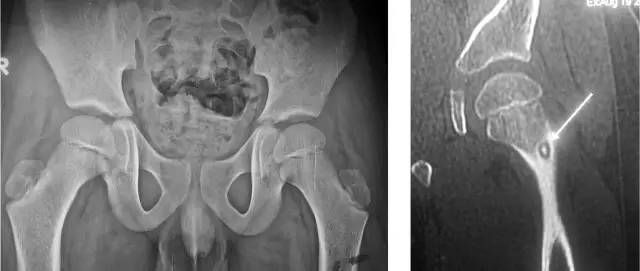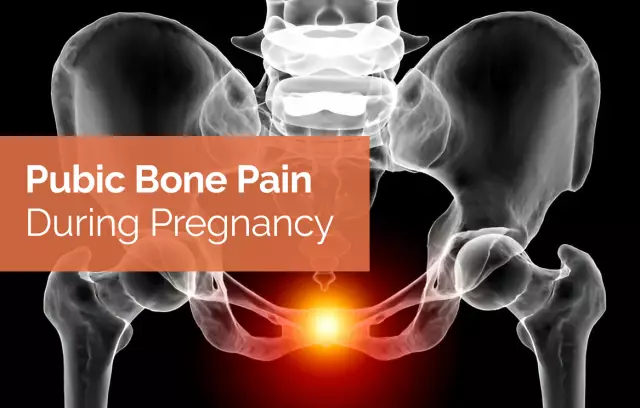- Author Rachel Wainwright [email protected].
- Public 2023-12-15 07:39.
- Last modified 2025-11-02 20:14.
Osteoma
Osteoma is a benign, delimited bone neoplasm originating from the bone and consisting of bone tissue, long and slow growing and having the appearance of a hemisphere. Previously, the concept of an osteoma, regardless of origin, included all bone formations (traumatic, blastomatous, inflammatory and neuropathic), but at present, with all the difficulty of distinguishing a tumor from a hyperplastic formation in medicine, the above growths are no longer referred to as an osteoma.

The tumor forms on the bones of the skeleton and is often found on the femur, key, temporal and frontal bones, as well as in the cavities and orbit of the facial bones. Osteoma of the frontal bone and sphenoid bone often originates from embryonic cartilage debris.
The osteoma located above the surface of the bone is called exostosis, and the one contained in the spongy substance is called enostosis.
Usually there are solitary tumors (solitary), however, there are also multiple exostoses, which are systemic diseases and belong to echondromas. In very rare cases, there is an osteoblastoma originating from osteoblasts, which stands on the border between benign neoplasms and sarcomas (malignant tumors).
Osteoma causes
In some cases, especially with multiple exostoses, osteoma appears due to a hereditary predisposition, since with a probability of 50% the disease is transmitted to direct descendants. Also, the causes of osteoma are:
Congenital exostoses;
- Injuries;
- Syphilis;
- Gout;
- Rheumatism.
Osteoma classification
The osteoma of the bone is divided according to the order of structure into the following types:
Solid, which consists of a dense compact substance resembling ivory. This substance does not contain bone marrow and almost completely does not contain Havers' canals;
Spongy, which consists of a porous spongy substance;
The cerebral, which consists of large wide bone marrow cavities.
By genesis, osteomas are also divided into epiphyseal and periosteal exostoses.
Osteoma structure
Bone osteoma contains bony plates with bony bodies lying among them. These plates are located around the Haversian canals and the medullary space. Depending on the above types of tumor, the number of Havers' canals and the size of the bone marrow space fluctuate. The bone tissue that makes up the frontal bone osteoma often consists of cartilaginous islets embedded in the subcortical layer or spongy substance.
Osteoma symptoms

Often, osteoma develops asymptomatically, and painful sensations appear only when the tumor is an obstacle to the movement of the bone or presses on the nerve. When the tumor is located on the upper lamina of the skull bones, headaches, epileptic seizures and memory problems can occur. If the osteoma is located in the nasal sinuses, then visual impairment occurs, and when the tumor is localized in the region of the sphenoid bone of the skull, hormonal disturbances are observed.
Osteoma treatment
Initially, based on the results of clinical and radiological data, a diagnosis of osteoma is made, after which treatment is prescribed.
Osteoma treatment consists of radical removal of the tumor. Surgical intervention is indicated for organ dysfunctions, severe pain, growth retardation and changes in the shape of the bones, which lead to limited mobility and impaired statics of the limbs. During the operation, the surgeon removes the tumor, after which he resects the underlying healthy bone plate. If the course of the disease is not accompanied by symptoms and the tumor is small, it is considered appropriate to conduct dynamic observation.
The information is generalized and provided for informational purposes only. At the first sign of illness, see your doctor. Self-medication is hazardous to health!






